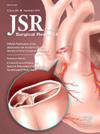手术创伤与死亡率:体积的作用。
IF 1.8
3区 医学
Q2 SURGERY
引用次数: 0
摘要
导言:在许多外科专科中,手术量都与预后的改善有关,但在创伤外科中,这种关系尚未得到明确说明。本研究试图评估创伤手术量与死亡率之间的关系,假设手术量的增加与生存率的提高有关:在国家创伤数据库中查询了 2017 年至 2020 年期间在一级或二级创伤中心接受出血控制手术的年龄≥18 岁的患者。在控制人口统计学和临床特征的前提下,进行了层次逻辑回归,以评估手术量与院内死亡率之间的关系:共纳入 55,469 名患者,他们在 516 个中心接受治疗。经调整后,手术量与死亡率的降低显著相关(OR 0.999,95% CI 0.997-0.999,P = 0.018)。然而,手术量存在很大差异,最繁忙的5%的中心每年进行90-294例手术,而中间50%的中心每年进行7-35例手术。为了评估手术量是否会产生一致的影响,在子集分析中排除了前5%的创伤中心,手术量在剩余的491个中心中变得不显著(OR 0.999,95% CI 0.996-1.001,P = 0.274):结论:创伤手术量越大,接受出血控制手术的患者死亡率就越低,但这种死亡率的益处似乎只来自于手术量非常大的中心。由于出血控制手术具有时间敏感性,因此在这一层面进行集中管理是不切实际的。未来的工作重点应该是研究患者距离创伤中心的远近与中心规模之间的关系,以及确定可广泛实施的高规模中心的共同可调节因素。本文章由计算机程序翻译,如有差异,请以英文原文为准。
Operative Trauma and Mortality: The Role of Volume
Introduction
Operative volume is associated with improved outcomes across many surgical specialties, but this relationship has not been illustrated clearly in trauma. This study sought to evaluate the relationship between operative trauma volume and mortality, hypothesizing that increased volume would be associated with improved survival.
Materials and Methods
The National Trauma Data Bank was queried for patients ≥18 y undergoing hemorrhage control surgery at level I or II trauma centers from 2017 to 2020. Hierarchical logistic regression was performed to evaluate the association between operative volume and in-hospital mortality, controlling for demographic and clinical characteristics.
Results
55,469 patients were included and treated at 516 centers. After adjustment, the operative volume was significantly associated with reduced mortality (OR 0.999, 95% CI 0.997-0.999, P = 0.018). However, there was considerable variability in volumes, with the busiest 5% of centers performing 90-294 operations per year, compared to 7-35 in the middle 50% of centers. To evaluate whether volume exhibited a uniform effect, the top 5% of trauma centers were excluded on subset analysis, with operative volume becoming nonsignificant in the remaining 491 centers (OR 0.999, 95% CI 0.996-1.001, P = 0.274).
Conclusions
Higher operative trauma volume is associated with reduced mortality for patients undergoing hemorrhage control surgery, but this mortality benefit appears to arise solely from very high-volume centers. The time-sensitive nature of hemorrhage control surgery makes centralization at this level impractical. Future efforts should focus on investigating the relationship between patient proximity to trauma centers and center volume as well as identifying modifiable factors common to high-volume centers that may be widely implemented.
求助全文
通过发布文献求助,成功后即可免费获取论文全文。
去求助
来源期刊
CiteScore
3.90
自引率
4.50%
发文量
627
审稿时长
138 days
期刊介绍:
The Journal of Surgical Research: Clinical and Laboratory Investigation publishes original articles concerned with clinical and laboratory investigations relevant to surgical practice and teaching. The journal emphasizes reports of clinical investigations or fundamental research bearing directly on surgical management that will be of general interest to a broad range of surgeons and surgical researchers. The articles presented need not have been the products of surgeons or of surgical laboratories.
The Journal of Surgical Research also features review articles and special articles relating to educational, research, or social issues of interest to the academic surgical community.

 求助内容:
求助内容: 应助结果提醒方式:
应助结果提醒方式:


